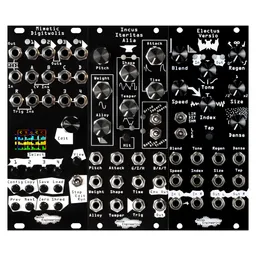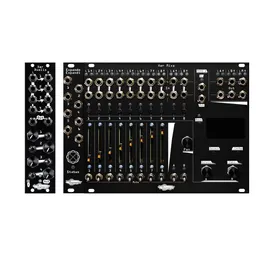We’ve discussed the fundamentals of subtractive synthesis in a previous post, and today we’ll be exploring a different technique called frequency modulation, or FM, synthesis. FM uses multiple oscillators to create bright and often metallic sounds or bell-like that are very different from the things you’ll hear from subtractive patches.
What is FM synthesis?
FM synthesis can be very complex, but it can also be used to great effect in very simple patches. In FM’s most basic form, an oscillator modulates another oscillator’s frequency at audio rate, which changes its timbre. In this sound example, you can hear one sine wave modulate another sine wave, and as the modulating oscillator’s frequency increases, it stops sounding like vibrato and starts sounding like an entirely new timbre:
FM terminology: modulators, carriers, and ratios
When talking about FM patches, oscillators have a unique terminology. Oscillators are referred to as operators, and are described by their function in a patch: an oscillator that you monitor directly is called a carrier, and an oscillator that modulates the frequency of another oscillator is called the modulator.
Oscillator frequency on traditional FM synthesizers is also defined by ratio, instead of frequency: if one oscillator has a ratio of 1 and another a ratio of 4, it will be four times the frequency of the other.
This terminology may seem odd at first, but it makes it easy to describe the structure of an FM patch, and what a particular oscillator is doing.

Patching FM in Eurorack
Desktop and software FM synthesizers often use high numbers of operators (oscillators): for instance, the Yamaha DX7 used up to 6 operators in various routings to create its distinct timbres.
However, recreating something like that in Eurorack would be extremely costly and difficult to patch, and fantastic sounds can be created with few oscillators as well. If you have two oscillators with FM inputs, you can create a huge amount of timbres just by changing the frequencies of the oscillators, and how much the carrier oscillator is modulated by putting an attenuator or VCA before its FM input. Traditional FM only uses sine waves, but since Eurorack oscillators generally have multiple waveforms, we can create even more sounds by playing with different waveshapes – I particularly like the aggressive sound of FM with saw waves.
Two-operator FM is also commonly used in complex oscillators. Complex oscillators contain two (or more) oscillators that modulate each other’s frequency, and a wavefolder (or other timbre-shaping utilities) to further process an oscillator’s outputs. These have been used in modular systems for decades, and are a wonderfully diverse sound source.
For advanced patchers: audio-rate modulate all the things
FM is just one way of using audio-rate modulation to create new timbres. Things like ring modulation and amplitude modulation are well known synthesis techniques, but in modular, we have almost no limitation on what can be modulated. Try plugging an oscillator into any CV input on your system and see what happens! I’m a big fan of modulating filter frequencies and wavefolders at audio rates – it’s a great way to create buzzy, warbly timbres. You can’t hurt a module by modulating it too fast, and so much of making music is exploring those happy accidents, so experiment without fear!







